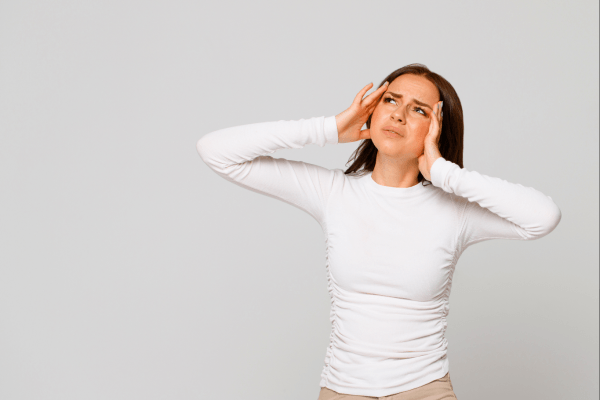Most people associate hormones with reproduction, mood swings, or skin changes, but few realize how deeply they affect another essential bodily function: balance. The vestibular system—our internal “GPS” for orientation and equilibrium—can be significantly influenced by hormonal fluctuations. For many women, this connection becomes most evident during menstruation, ovulation, pregnancy, perimenopause, and menopause. In fact, conditions like vestibular migraine are often exacerbated by these hormonal shifts, creating a unique and often overlooked set of challenges for those affected.
In this article, we’ll explore how hormones interact with the vestibular system throughout different stages of life and examine potential treatment options, including the increasingly valuable role of vestibular physiotherapy.
The Vestibular System: A Brief Overview
The vestibular system is a complex network located within the inner ear and brain, responsible for maintaining balance, spatial orientation, and stable vision during movement. It includes structures such as the semicircular canals and the otolith organs, which work in tandem with the brainstem and cerebellum to interpret head position and motion. When this system is disrupted—whether by injury, disease, or internal chemical changes—it can result in dizziness, vertigo, motion sensitivity, and imbalance.
While vestibular disorders can have many origins, hormonal fluctuations are a common and often underdiagnosed contributor, particularly in women. Hormones like estrogen and progesterone influence neurological, vascular, and even fluid-regulation systems in the body, all of which intersect with vestibular function. Understanding these intersections is critical for effective diagnosis and treatment.
Hormonal Influence During the Menstrual Cycle
For many women, vestibular symptoms such as dizziness, imbalance, and even full-blown vestibular migraines become more pronounced in the days leading up to menstruation. This is the luteal phase of the cycle, when both estrogen and progesterone levels drop sharply. That decline doesn’t just affect mood or energy; it can also destabilize the nervous system.
Estrogen plays a key role in modulating neurotransmitters like serotonin and dopamine, which help regulate sensory processing and mood. As estrogen drops, so does the stability of these chemical messengers, potentially triggering migraines or increasing sensitivity to motion and sensory stimuli. For those already prone to vestibular disorders, this shift can be enough to cause a flare-up of symptoms.
Progesterone, too, has a calming effect on the nervous system. When it declines, many women feel more anxious, more sensitive to light and sound, and less resilient to stress. All of these factors can exacerbate vestibular symptoms, leading to increased dizziness, feelings of “brain fog,” and instability.
The Subtle Shift of Ovulation
Mid-cycle, ovulation brings a surge of estrogen and a rise in luteinizing hormone. For most, this is a time of increased energy and focus. However, for those sensitive to hormonal shifts, this brief peak in estrogen can also be problematic. Some women experience mild dizziness, disorientation, or heightened motion sensitivity during ovulation, often without recognizing the hormonal connection.
What’s particularly tricky about ovulation is that the symptoms are often subtle and short-lived—perhaps a day or two of mild imbalance or a fleeting sense of vertigo. But for women with vestibular migraine or chronic vestibular disorders, even these small hormonal shifts can trigger more noticeable episodes of dizziness or a migraine with vestibular features.
Pregnancy and the Vestibular System: A Delicate Balance

Pregnancy is a time of profound hormonal upheaval. Estrogen and progesterone levels rise dramatically, especially during the first trimester. While these hormones are vital for maintaining a healthy pregnancy, they can have unintended effects on the vestibular system.
Many pregnant individuals experience dizziness or lightheadedness, particularly in early pregnancy. This may be due to a combination of factors: hormonal effects on blood vessels, changes in blood pressure, fluctuations in blood sugar, and increased blood volume. Estrogen can affect the regulation of fluid in the inner ear, possibly altering the delicate balance of endolymph—the fluid responsible for transmitting motion signals. This can result in sensations of vertigo or unsteadiness, even in women with no prior vestibular issues.
As pregnancy progresses, the physical and postural changes of a growing belly can also place greater demands on the vestibular system. Shifts in center of gravity, ligament laxity, and increased fatigue make balance a bit more challenging. For those with pre-existing vestibular conditions, pregnancy may either worsen or, in some cases, improve symptoms—highlighting just how individualized hormonal effects can be.
Perimenopause: Hormonal Chaos Meets Vestibular Vulnerability
If there’s one stage of life where vestibular symptoms frequently spike, it’s perimenopause. This transitional phase leading up to menopause is marked by erratic and unpredictable fluctuations in estrogen and progesterone. Periods may become irregular, sleep may be disrupted, and mood swings become more common. But among these familiar signs, many women are surprised to find themselves dealing with new or worsening symptoms of dizziness, motion sensitivity, or even persistent vertigo.
The reason lies in the brain’s reliance on estrogen to regulate blood flow, maintain neurotransmitter balance, and modulate the sensory processing centers. When hormone levels swing dramatically—as they often do during perimenopause—the vestibular system struggles to keep up. Many women develop symptoms resembling vestibular migraine, even if they’ve never had migraines before. Others experience a constant feeling of imbalance or a sense that their head is in a fog.
Compounding the issue is the fact that perimenopause often coincides with increased stress, disrupted sleep, and midlife changes that can amplify vestibular symptoms. Unfortunately, many women are told these symptoms are psychological or “just hormonal,” when in fact they reflect genuine neurological changes.
Menopause: A New Hormonal Baseline
Once menopause is reached—defined as 12 consecutive months without a period—hormone levels, particularly estrogen and progesterone, drop and stabilize at a new low baseline. While this may bring some relief from the rollercoaster of perimenopausal symptoms, many women continue to experience vestibular challenges well into postmenopause.
The loss of estrogen’s protective effects on the nervous system and inner ear can result in ongoing balance problems, increased motion sensitivity, and a heightened risk of falls. For some, vestibular migraines persist or worsen. Others may notice a general decline in sensory resilience, making it harder to tolerate crowded places, bright lights, or sudden movements.
Additionally, menopause brings age-related changes to the brain and vestibular system, including reduced blood flow, slowed neural transmission, and degeneration of inner ear structures. These changes, combined with hormonal loss, may account for why dizziness and imbalance become more common in older adults—especially women.
Vestibular Migraine and Hormones: A Complicated Relationship
Vestibular migraine is a neurological condition that blends migraine symptoms with disturbances of balance and spatial orientation. Unlike classic migraines, vestibular migraine does not always involve a headache. Instead, individuals may experience vertigo, motion sensitivity, visual disturbances, or a sense of disorientation.
Common symptoms of vestibular migraine include:
- Episodic vertigo or a spinning sensation, lasting minutes to hours
- Imbalance or unsteadiness
- Motion sensitivity (especially in cars, stores, or crowded places)
- Visual disturbances such as blurred vision, photophobia, or seeing shimmering patterns
- Pressure in the head or ears
- Nausea, sometimes accompanied by vomiting
- Brain fog or difficulty concentrating
- Sensitivity to sound and light
- Headache (which may or may not occur alongside vestibular symptoms)
Hormonal changes are a key trigger for vestibular migraine in many women. The cyclical nature of estrogen and progesterone appears to sensitize the brain’s migraine pathways, especially during times of fluctuation such as menstruation, ovulation, pregnancy, and perimenopause. The result is a condition that feels unpredictable, debilitating, and often difficult to diagnose.
Despite its prevalence, vestibular migraine is frequently misdiagnosed—often mistaken for anxiety, panic disorder, or even inner ear disease such as Vestibular Neuritis. This is partly because hormonal vestibular symptoms can mimic a variety of other conditions. Yet once identified, vestibular migraine can often be managed effectively with the right combination of treatments.
Treatment Options for Hormone-Related Vestibular Symptoms
Managing vestibular symptoms that stem from hormonal changes requires a multifaceted approach. Because no two individuals experience these changes the same way, treatment must be personalized, often blending medical, rehabilitative, and lifestyle strategies.
Medical Treatments
Hormone replacement therapy (HRT) may offer relief for some women experiencing severe vestibular symptoms in menopause. By stabilizing estrogen levels, HRT can reduce the frequency and intensity of migraines and help regulate nervous system activity. However, HRT is not suitable for everyone and should be considered carefully in consultation with a healthcare provider.
Vestibular Physiotherapy: A Cornerstone of Recovery
Vestibular physiotherapy, also known as vestibular rehabilitation therapy (VRT), is one of the most effective non-pharmacological treatments for vestibular dysfunction. It involves a tailored set of exercises designed to retrain the brain and body to adapt to changes in balance and motion processing.
Through a combination of habituation and balance training, vestibular physiotherapy helps improve stability and reduce dizziness over time. It also empowers individuals to better manage their symptoms and regain confidence in movement.
What makes vestibular physiotherapy especially valuable for hormonally triggered symptoms is its flexibility. Therapists can adjust exercise intensity based on where a woman is in her menstrual or menopausal cycle. This level of customization makes it easier to avoid symptom flare-ups while still making meaningful progress.
Lifestyle and Supportive Therapies
Diet, hydration, and stress management all play a role in vestibular health. Staying well-hydrated supports inner ear function and circulation, and maintaining balanced blood sugar levels can help reduce dizziness, especially around hormonal shifts.
Regular exercise, particularly yoga and tai chi, can help recalibrate the balance system and reduce the risk of falls. Mindfulness and breathing practices are valuable for reducing anxiety and calming the nervous system, especially during hormonally vulnerable times. Because sleep is a major modulator of vestibular and migraine symptoms, prioritizing sleep hygiene is crucial—especially during perimenopause, when insomnia is common.
Supplements such as Magnesium Glycinate, Vitamin B2 (riboflavin), and CoQ10 have shown some benefit in reducing migraine frequency, including vestibular migraine. Always consult a healthcare provider before starting new supplements, especially if you are pregnant, nursing, or taking medications.
The Power of Tracking
For anyone navigating hormonally influenced vestibular symptoms, tracking is a powerful tool. Keeping a journal or using an app to log symptoms, menstrual cycle phases, medications, sleep quality, and stress levels can reveal patterns that might otherwise go unnoticed. This information can help guide treatment, inform timing for vestibular physiotherapy, and allow for proactive planning around trigger times.
Conclusion: Hormonal Dizziness Is Real—And Treatable
If you’ve ever felt dismissed or told “it’s just hormones” when struggling with dizziness or vertigo, you’re not alone. The reality is that hormonal changes exert real, measurable effects on the vestibular system. From monthly cycle fluctuations to the upheaval of pregnancy or the transition through menopause, these changes can disrupt the body’s sense of balance in complex ways.
But understanding this connection also opens the door to effective treatment. With the right diagnosis, medical support, rehabilitative therapy, and lifestyle adjustments, it’s possible to manage and even significantly reduce hormonally influenced vestibular symptoms. You don’t have to accept dizziness or disorientation as a normal part of being female—it’s a treatable condition, and help is available – such as at The Vertigo Co.






